In the first two installments of this series, I looked at exploring a new star system and examining a planet from orbit. Depending on the level of detail you want, this could take a few days to a few years… for each planet. With 15,000 star systems to explore within 100 light years from Earth, how are we going to do this in a reasonable amount of time, even with our nifty FTL survey ships?
I think the best solution is to parallelize as much as possible. That is, throw more manpower at it, or in this case, more ship-power. Since it takes some number of orbits around a planet to map it with the desired detail, the best way to speed that up is to do multiple orbits at once by employing satellites rather than simply orbit in the ship.
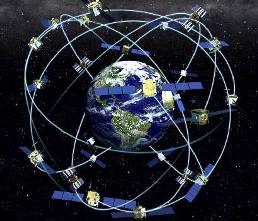 Such satellites would not need independent launch systems. The ship could assume the desired orbit, lower the satellite out of a cargo bay, and gently move off towards the next desired orbit. That way, something that would have taken a few days could be done in one.
Such satellites would not need independent launch systems. The ship could assume the desired orbit, lower the satellite out of a cargo bay, and gently move off towards the next desired orbit. That way, something that would have taken a few days could be done in one.
Alternatively, if a particular system has more than one planet (or moon) in need of such mapping, a portion of the satellites could be deployed at one world, left to do their survey, while the ship goes to another world to deploy more of the satellites. In our solar system, this would be the equivalent of populating Earth’s orbit with observation satellites, popping over to Mars in mere moments using your nifty FTL drive to seed it with satellites. You might even dash out to Jupiter to set one around Europa. By the time you had set all that up, it would be time to swing back to Earth to collect your satellites and their data.
In fact, if one world in particular deserved a longer, high-resolution look, then one or more satellites could be left in place while the ship moves on to another star system entirely. It could then come back after a few months and collect a wealth of information. This would be useful if you saw signs of life or hints of artificial constructs on the ground and wanted to get that 1-meter resolution scan, or perhaps even zoom in further on the really interesting spots. I would not propose to attempt reading the New Rigel Times over someone’s shoulder, but you might discover that he did, in fact, have a shoulder to begin with.
How many satellites should the ship carry? All I have is a gut feeling for bringing about a dozen. It would be great to have hundreds, but when you start thinking about the big optical lenses, these satellites are bulky. A dozen should not take up an unreasonable amount of room, and it gives the survey crew enough to check out multiple planets at once as well as a few to leave behind without impairing the rest of the survey mission.
I would also want to carry along a number of communication satellites to be left in key locations. If my FTL communication system requires boosters or relays, it would make sense to leave them near interesting worlds, technology willing. And if the FTL communication is via courier ships, then these message queue satellites should be left at predictable locations, i.e. around promising stars near planets in the habitable zones. Hopefully, these could be of a reasonable size. It would be nice to leave one in every star system visited, but failing that, it would be nice to leave behind five or ten.
So how long will this take? I think with the extra satellites, a star system could get a decent exploration in about five days. For convenience, I’m going to assume an FTL speed of about one light year per day, and say that we can get from one system to the next in an average of five days. Yes, the distance varies from 10 light years for solitary stars to less than one for places like the Pleiades, but we’re into hand-waving territory here. This might take even longer when you considering the problems of efficient routing (i.e. the travelling salesman problem) and the inevitable backtracking to pick up any satellites we left behind, slowing us down just a little more. Then again, there’s nothing to stop me from waving my hands again and saying two light years per day. So let’s stick with five days travel between stars.
So, put those together, and you can explore a new star system every 10 days, and I think that’s pretty optimistic.
 But how long will you explore? I’m going to use the U.S. Navy as a guide, and while ship deployment lengths vary, few are longer than six months at a time. Some of this is supplies. Some of it is wear and tear on the equipment (being as sea is kind of rough on things). But I think a lot of it is simply the limits of the human psyche. While visiting Alexandria, Hong Kong, or Rio de Janeiro can ease the stress, the real test would be those guys riding it out alone on the nuclear subs, and I believe their tours are no more than six months.
But how long will you explore? I’m going to use the U.S. Navy as a guide, and while ship deployment lengths vary, few are longer than six months at a time. Some of this is supplies. Some of it is wear and tear on the equipment (being as sea is kind of rough on things). But I think a lot of it is simply the limits of the human psyche. While visiting Alexandria, Hong Kong, or Rio de Janeiro can ease the stress, the real test would be those guys riding it out alone on the nuclear subs, and I believe their tours are no more than six months.
So is that six months of survey? Well, sure, as long as we’re only exploring the neighborhood right nearby, but as time goes by, we’ll be exploring further and further afield. Even at a light-year per day, we could spend three months getting out to those worlds in the 90-100ly range only to have to turn around and come back home.
So I’m going to assume that as the project progresses, we build up some forward bases. In fact, one of jobs of this survey would be to find good locations for those forward bases. Some of those more interesting worlds could be candidates for terraforming and eventual colonization. Building a meeting place for crews to get a little rest, repairs, and crew rotation would be a decent place to start with such an effort. Welcome to Deepspace-84.
So, I’ll assume that for the duration of the project, the survey area for a particular six month tour is roughly 30 days from a forward base. Furthermore, I’m going to give them two months of downtime back at that base. Ships will need maintenance, resupply, upgrades, and so on. Plus, it gives them some leeway in their schedule if they run a little behind.
After setting aside 60 days to get to and from the survey area, that leaves us with about 120 days to survey, and at ten days per star system, that’s only twelve new star systems. Add in the two months of downtime between survey missions, and that’s twelve new star systems per eight months. Since we’ll certainly be having more than one ship doing this, let’s average it out to only eighteen star systems per ship-year.
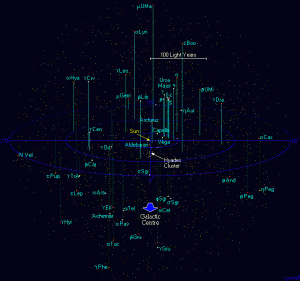 Now, how many stars were we talking about? Oh yeah, 15,000 stars within 100 light years. At the survey rate I’ve given, that’s about 830 ship-years worth of survey. If we want to do this in as little as twenty years, that means about 42 survey ships. Maybe even bump that up to fifty for some inevitable problems that we’ll run into along the way.
Now, how many stars were we talking about? Oh yeah, 15,000 stars within 100 light years. At the survey rate I’ve given, that’s about 830 ship-years worth of survey. If we want to do this in as little as twenty years, that means about 42 survey ships. Maybe even bump that up to fifty for some inevitable problems that we’ll run into along the way.
Considering that the U.S. Navy has varied from 250-600 ocean-going ships over the last century, fifty ships does not seem an unreasonable number of ships to dedicate to such an effort. I’ve been imagining these ships as being fairly lightly crewed by naval standards, requiring probably only forty to one hundred crew each, but that’s still a few thousand crew.
But even 5000 is not that many people, especially considering the number of Earthbound explorers who would be dying for a chance at it. I know I would be eager to put in my resume. Even if I don’t get in on this one, I might still have a shot at the next phase of scoping out the 100,000 stars in the next 100 light years out from there.
Wouldn’t you want to spend a few years of your life on something like this?
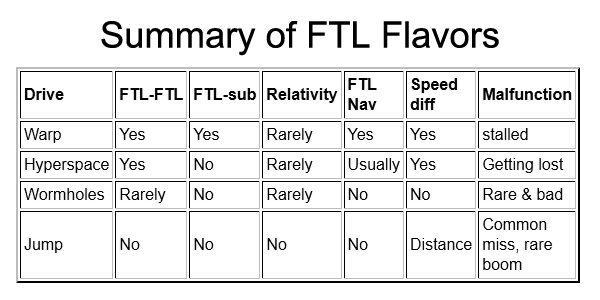

 This is the fourth in my series on various flavors of Faster Than Light (FTL) travel, and today I’m dropping into wormholes. The basic idea of a wormhole is that it’s a shortcut between two points. Usually they are fixed points, but there’s some variation on that. Sometimes they are done as predefined shortcuts through some alternate parallel space, and other times they are special tunnels through our own space.
This is the fourth in my series on various flavors of Faster Than Light (FTL) travel, and today I’m dropping into wormholes. The basic idea of a wormhole is that it’s a shortcut between two points. Usually they are fixed points, but there’s some variation on that. Sometimes they are done as predefined shortcuts through some alternate parallel space, and other times they are special tunnels through our own space.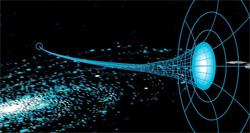 But one last bit on wormholes. Like the warp drive, these might be possible if not actually feasible. What we call a wormhole is remarkably similar to a prediction of General Relativity, known more properly as a Einstein-Rosen Bridge. However, since our best theoretical examples of such wormholes are tied up with black holes, this still has a long way to go to before we can turn it into the green-line express from Sol to Rigel.
But one last bit on wormholes. Like the warp drive, these might be possible if not actually feasible. What we call a wormhole is remarkably similar to a prediction of General Relativity, known more properly as a Einstein-Rosen Bridge. However, since our best theoretical examples of such wormholes are tied up with black holes, this still has a long way to go to before we can turn it into the green-line express from Sol to Rigel. This is the third in my series on different flavors of Faster Than Light (FTL) travel, and today I’m taking a look at hyperspace. The general idea here is that there is a separate space, parallel to our own, that allows for shorter travel between two points. It’s no longer four light years to Proxima. Instead, you transition over to hyperspace, travel a hundred thousand kilometers, and drop back into normal space at Proxima.
This is the third in my series on different flavors of Faster Than Light (FTL) travel, and today I’m taking a look at hyperspace. The general idea here is that there is a separate space, parallel to our own, that allows for shorter travel between two points. It’s no longer four light years to Proxima. Instead, you transition over to hyperspace, travel a hundred thousand kilometers, and drop back into normal space at Proxima. The only tricky thing about hyperspace is getting between normal space and hyperspace. In some stories, your ship can contain the necessary equipment to open a transition point. In other tales, it requires a gate in normal space to open that transition point. But once you’re over in hyperspace, it’s just a matter of throttling up or sailing away.
The only tricky thing about hyperspace is getting between normal space and hyperspace. In some stories, your ship can contain the necessary equipment to open a transition point. In other tales, it requires a gate in normal space to open that transition point. But once you’re over in hyperspace, it’s just a matter of throttling up or sailing away.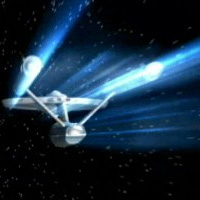 This is the second in my series on the different flavors of Faster Than Light (FTL) travel, and today I’ll be looking at the warp drive. The ideas for warp drive predate Star Trek, and they weren’t always called by that name, but Captain Kirk and the Enterprise are the iconic example of the warp drive. With a few words of technobabble, the universal speed limit is suddenly gone.
This is the second in my series on the different flavors of Faster Than Light (FTL) travel, and today I’ll be looking at the warp drive. The ideas for warp drive predate Star Trek, and they weren’t always called by that name, but Captain Kirk and the Enterprise are the iconic example of the warp drive. With a few words of technobabble, the universal speed limit is suddenly gone.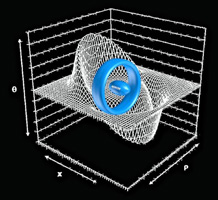 But ironically, this flagrant slap in the face to physics is starting to look like it just might, maybe, theoretically be almost possible. In 1994, Miguel Alcubierre proposed a way of changing the shape of space around us, shrinking it in the direction we wanted to travel and expanding it in the direction behind us. It requires some pretty crazy technology, the science for which is still pure speculation, but after about twenty years, it has a few people seriously considering it as a matter for research. How seriously? Apparently NASA is spending some of its precious half-pennies on it. It might not be much more than a publicity stunt, but there’s always that outside chance that it might be something huge.
But ironically, this flagrant slap in the face to physics is starting to look like it just might, maybe, theoretically be almost possible. In 1994, Miguel Alcubierre proposed a way of changing the shape of space around us, shrinking it in the direction we wanted to travel and expanding it in the direction behind us. It requires some pretty crazy technology, the science for which is still pure speculation, but after about twenty years, it has a few people seriously considering it as a matter for research. How seriously? Apparently NASA is spending some of its precious half-pennies on it. It might not be much more than a publicity stunt, but there’s always that outside chance that it might be something huge.

